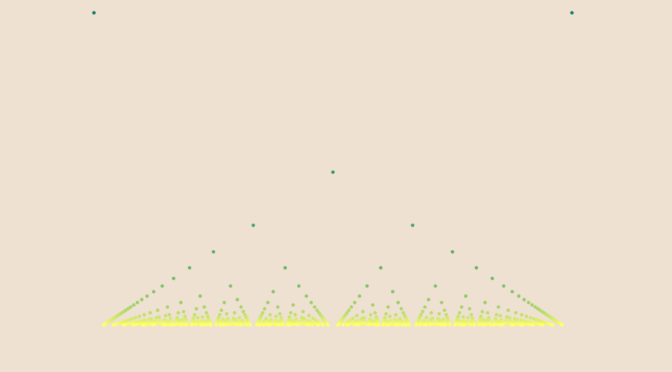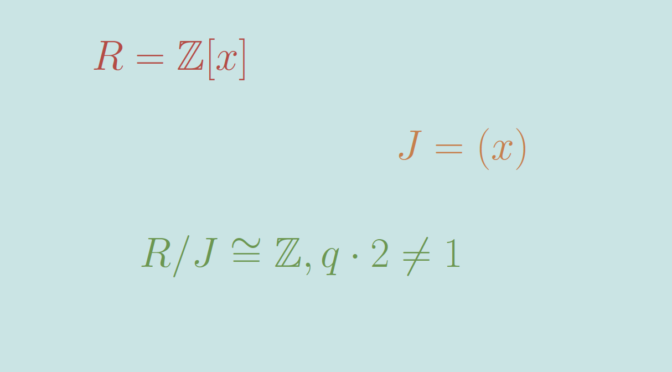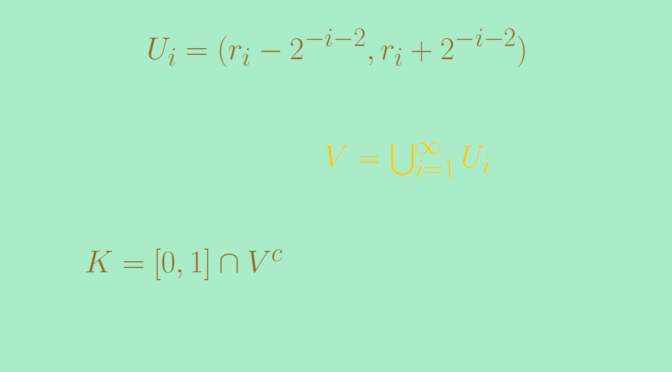
Let’s come back to Thomae’s function which is defined as:
\[f:
\left|\begin{array}{lrl}
\mathbb{R} & \longrightarrow & \mathbb{R} \\
x & \longmapsto & 0 \text{ if } x \in \mathbb{R} \setminus \mathbb{Q} \\
\frac{p}{q} & \longmapsto & \frac{1}{q} \text{ if } \frac{p}{q} \text{ in lowest terms and } q > 0
\end{array}\right.\]
We proved here that \(f\) right-sided and left-sided limits vanish at all points. Therefore \(\limsup\limits_{x \to a} f(x) \le f(a)\) at every point \(a\) which proves that \(f\) is upper semi-continuous on \(\mathbb R\). However \(f\) is continuous at all \(a \in \mathbb R \setminus \mathbb Q\) and discontinuous at all \(a \in \mathbb Q\).

Every maximal ideal is a prime ideal. The converse is true in a principal ideal domain – PID, i.e. every nonzero prime ideal is maximal in a PID, but this is not true in general. Let’s produce a counterexample.
\(R= \mathbb Z[x]\) is a ring. \(R\) is not a PID as can be shown considering the ideal \(I\) generated by the set \(\{2,x\}\). \(I\) cannot be generated by a single element \(p\). If it was, \(p\) would divide \(2\), i.e. \(p=1\) or \(p=2\). We can’t have \(p=1\) as it means \(R = I\) but \(3 \notin I\). We can’t have either \(p=2\) as it implies the contradiction \(x \notin I\). The ideal \(J = (x)\) is a prime ideal as \(R/J \cong \mathbb Z\) is an integral domain. Since \(\mathbb Z\) is not a field, \(J\) is not a maximal ideal.

Let’s build a totally disconnected compact set \(K \subset [0,1]\) such that \(\mu(K) >0\) where \(\mu\) denotes the Lebesgue measure.
In order to do so, let \(r_1, r_2, \dots\) be an enumeration of the rationals. To each rational \(r_i\) associate the open interval \(U_i = (r_i – 2^{-i-2}, r_i + 2^{-i-2})\). Then take \[
\displaystyle V = \bigcup_{i=1}^\infty U_i \text{ and } K = [0,1] \cap V^c.\] Clearly \(K\) is bounded and closed, therefore compact. As Lebesgue measure is subadditive we have \[
\mu(V) \le \sum_{i=1}^\infty \mu(U_i) \le \sum_{i=1}^\infty 2^{-i-1} = 1/2.\] This implies \[
\mu(K) = \mu([0,1]) – \mu([0,1] \cap V) \ge 1/2.\] In a further article, we’ll build a totally disconnected compact set \(K^\prime\) of \([0,1]\) with a predefined measure \(m \in [0,1)\).
Mathematical exceptions to the rules or intuition



